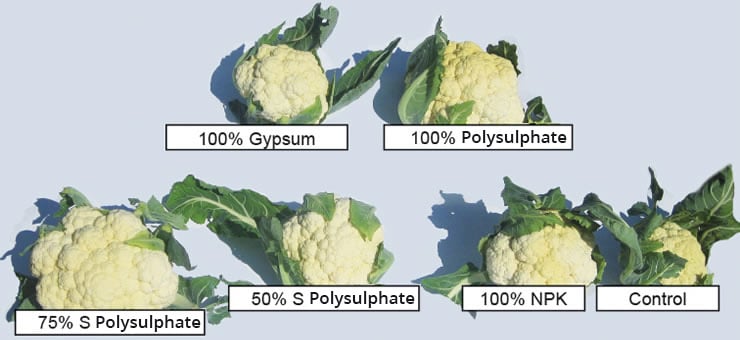Polysulphate podporuje růst brukvovitých
Výzkum dvou indických vědců prokázal, že hnojivo Polysulphate poskytuje plodinám rodu Brassica to, co potřebují k dosažení špičkových výnosů.
Je všeobecně známo, že síra je důležitou rostlinnou makroživinou. Síra je spojena s vysokým výnosem a dobrou kvalitou, zejména u brukvovitých. Je také jednou z hlavních živin obsažených v Polysulphatu, našem hnojivu vyrobeném z přírodního minerálu polyhalitu, což je hydratovaného síran draslíku (K), vápníku (Ca) a hořčíku (Mg).
Polysulfát zvyšuje produkci
Výzkumníci v Indii se rozhodli otestovat biologickou účinnost Polysulphatu na dvou hlavních plodinách Brassica oleracea: květáku a zelí. G. C. Satisha a A. N. Ganeshamurthy z indického výzkumného ústavu ICAR zveřejnili svá zjištění o Polysulfátu, které představují dobrou zprávu pro pěstitele těchto brukvovitých plodin.
Brukvovité plodiny, jako je květák a zelí, mají v indickém jídelníčku velké zastoupení a pro mnoho indických zemědělců jsou důležitými tržními plodinami. Výzkum zjistil, že aplikace síry vedla k výraznému zvýšení výnosu a kvality obou plodin. Podle výsledků indického výzkumu “nejvyšší výnosy zelí a květáku, o 32,8 %, resp. 39,5 % vyšší než u kontroly, byly dosaženy při 100 %, resp. 75 % doporučených dávek N-P-K a S, dodaných prostřednictvím Polysulphatu”.
Je třeba rozumět vzájemně propojené výživě rostlin
I když je užitečné zaměřit se na jednu rostlinnou živinu, jako je síra, je také důležité uvědomit si důležitou vzájemnou souvislost mezi všemi živinami obsaženými v Polysulphatu.
Právě to odhaluje indická výzkumná zpráva. Draslík obsažený v hnojivu Polysulphate zvyšuje příjem síry, zatímco síra naopak zřejmě podporuje příjem fosforu a vápníku.
U našeho Polysulphatu je aktivita – nebo bioúčinnost, jak ji označují výzkumníci – tohoto pozoruhodného, přirozeně se v přírodě vyskytujícího minerálního hnojiva více než jen souhrn účinku jeho složek. Znovu a znovu ukazuje jak mocný je to nástroj, který přináší pozoruhodné výsledky, ať už jde o brukvovité či jiné plodiny.
Přečtěte si kompletní studii Bioefficacy of Polyhalite Application on Yield and Quality of Cabbage and Cauliflower v e-ifc, který publikuje International Potash Institute.



